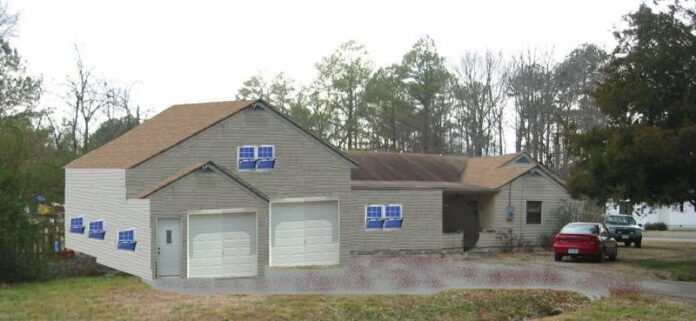“Drywall (load-bearing)”
By JACOB ANDERSON — arts@theaggie.org
In the realm of terrifying and arcane lore deep within the internet’s maw, the name “Groverhaus” turns heads among even the most steely-eyed of our digital veterans.
When anonymous users post photos of the lumpy, asymmetric house from within Microsoft Flight Simulator or Google Earth, with its illogically placed and mismatching windows, the double doors set strangely high without attendant steps, these learned users engage in a sort of silent worship for the house: it’s a symbol, an avatar of sorts for the months of heckling glee that once rang out on the Something Awful forums and, according to some, will never come again.
A moderator on the Something Awful forums by the username “grover” first introduced the world to his creation in a 2006 thread detailing how he had built a large extension to their house, comprising “a new kitchen, 2-car garage, workshop area, 3 bedrooms, a bathroom and a living room,” which grover, an electrical engineer by trade, had opted to construct completely on his own (with the notable exception of its concrete and siding).
Users lauded the initial posts in light of grover’s ambition, however it would be only pages before users took notice of the peculiarities in the construction: grover had insulated the stairs, built two incomprehensibly staggered garages right next to one another, posted pictures containing a section of plastic siding which had been obviously scorched off by a grill placed no more than two feet away and a diagram in which a section of the house is hilariously labeled “drywall (load-bearing),” all of which cued users into the incoming disaster of the house’s completion. Interested readers should check out the relevant pictures, as words do them no justice.
One exactly child-sized window is accidentally designed to double as a surface by which children tumbling down the stairs might fall half a story to the swampy, low-grade dirt on which the house was built and into which the extension would eventually sink, detaching from the rest of the house to the nude glee of thousands of Something Awful users. A house loaded with illogical windows and “load bearing” drywall was perhaps destined to sink into the earth in a place actually named the Great Dismal Swamp.
Hidden among this collection of hideous, hilarious tidbits is the specious claim that grover, upon inviting a house inspector to examine the house only for him to of course deem it completely unsafe, decided to become credentialed as an inspector so he could approve his own monstrous creation. This, in tandem with the myriad other poor decisions involved in the erection of the Groverhaus, speak to something in the character of grover bred from unfettered self-confidence and a paradoxical laziness which appears almost designed (far better than the ‘haus itself) to bring about this monument to myopia.
And so the denizens of Something Awful laughed, and they laughed, to the quiet displeasure of grover himself. In keeping with his status as moderator, though, he eventually decided that enough was enough: the thread was edited, pictures removed, and now those willing to take the deep journey into the net to find the original threads will find only remnants, contextless posts and broken image links, like the last ghosts of some great dining hall, once absorbed in interminable laughter, lingering only to say that something funny had once happened here.
Given how vociferous voices claiming that things posted online remain forever have become, the erasure of the original Groverhaus materials stands as an odd counterexample. Despite the thread’s legacy, in just fifteen years most of its original content has been lost. If these many claims regarding the indelibility of online things were true, how could such a legendary piece of internet history be exempt? In their absence is a handful of Twitter threads recounting the events with only fragmentary evidence, which, once again, appear to be more interested in asserting the fact that something funny had once happened than correctly accounting what that funny thing was.
Groverhaus’ position is interesting in that while the story isn’t properly preserved, neither is it gone, lost forever in a mess of archives and oft-repeated half-truths. It’s frozen in a halfway state, where rich glimmers of truth and history can be seen, but they remain joined to others long gone. In this sense, it could be seen as a warning to those using the internet today of what happens when archival goes under-prioritized, and of the fact that, even in small ways, things worth preserving continue to happen, even online.
To conclude, here are a few choice grover quotes, retrieved from that fractured thread:
“Also at this stage, we discovered that the 100’ fiberglass tape measure that I used to square off the foundation stretched about ¾” over 50’ and had f’ed up our foundation pins, making the one wall of our house 1.5” shorter than the other, [sic] and overall screwing up my perfect plans.” (Woe to grover’s perfect plans.)
“These walls do give a little- [sic] if you slam a door real hard, you can see if [sic] vibrate a bit. But I’m sure you have interior walls like that in Europe, too?” (Much of Europe, if you are unaware, has walls made of stone — far sturdier than your typical American house.)
Written by: Jacob Anderson — arts@theaggie.org




